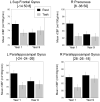Stability Of Default-Mode Network Activity In The Aging Brain
- PMID: 19568331
- PMCID: PMC2703608
- DOI: 10.1007/s11682-008-9054-z
Stability Of Default-Mode Network Activity In The Aging Brain
Abstract
Activity attributed to the default-mode occurs during the resting state and is thought to represent self-referential and other intrinsic processes. Although activity in default-associated regions changes across the lifespan, little is known about the stability of default-mode activity in the healthy aging brain. We investigated changes in rest-specific activity across an 8 year period in older participants in the Baltimore Longitudinal Study of Aging (BLSA) neuroimaging study. Comparison of resting-state and recognition memory PET regional cerebral blood flow conditions from baseline and 8-year follow-up shows relative stability of rest-specific activity over time in medial frontal/anterior cingulate, hippocampal and posterior cingulate regions commonly associated with the default-mode. In contrast, prefrontal, parahippocampal and occipital cortical regions, which are not typically associated with default-mode activity, show changes over time Overall, activity in the major components of the default-mode network remains stable in healthy older individuals, a finding which may assist in identifying factors that discriminate between normal and pathological aging.
Figures



References
-
- Andreasen NC, O'Leary DS, Cizadlo T, Arndt S, Rezai K, Watkins GL, et al. Remembering the past: two facets of episodic memory explored with positron emission tomography. Am J Psychiatry. 1995;152(11):1576–1585. - PubMed
-
- Buckner RL, Vincent JL. Unrest at rest: default activity and spontaneous network correlations. Neuroimage. 2007;37(4):1091–1096. discussion 1097-1099. - PubMed
Grants and funding
LinkOut - more resources
Full Text Sources
